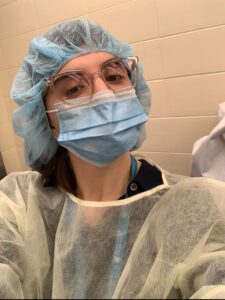In the summer following her first year at Earlham College, Drenushe Krasniqi-Vanmeter embarked on a transformative research project that would shape her future as a scientist. Under the mentorship of former Earlham professor Bob Rosenberg, she investigated the remarkable regenerative abilities of lampreys, exploring how these creatures can heal their spinal cords after injury. This research experience ignited her passion for research and solidified her commitment to understanding human health.
Graduating from Earlham in 2021 with a degree in biochemistry and a minor in medical humanities, Krasniqi-Vanmeter’s journey reflects a unique blend of scientific inquiry and personal history. Born in Kosovo’s capital city just before the outbreak of the Kosovo War, she grew up witnessing the lasting impact of war on her community, particularly on women who suffered grievously. An estimated 20,000 women were raped amid the chaos, a statistic that has fueled her commitment to social justice and healing.
“My family stayed in Kosovo during the war, and I felt the weight of those experiences deeply,” she recalls. This interest culminated in her independent study project at Earlham, where she focused on raising awareness about sexual violence survivors in Kosovo.
Krasniqi-Vanmeter’s commitment to her community continues to evolve. She is currently working with a research and development company in Kosovo to digitize survivors’ stories, collaborating with the Kosovo Rehabilitation Center for Tortured Victims. “Beyond the Shadows” is her initiative aimed at documenting these narratives as a form of social justice. The project is being supported by a peer-to-peer fundraising campaign.

“I want to use art and storytelling to raise awareness and funds for mental health resources, which are desperately needed,” she explains. “I don’t want to turn this into a political issue. By sharing these stories, we can create a more supportive environment for survivors. It’s very needed in the community. It’s very stigmatized. By talking about this and sharing this, more people will be comfortable sharing their story.”
Before Earlham, Krasniqi-Vanmeter enrolled at United World Colleges (UWC) Robert Bosch College in Freiburg, Germany, and was the first Albanian and only Albanian-speaking student in her cohort. The experience ignited her interest in environmental sustainability and solidified her resolve to make a difference through science.
“UWC and Earlham were critical in my journey because they taught me that education goes beyond the classroom,” Krasniqi-Vanmeter said. “I learned that the support of a community is crucial and being able to reach out to others is often maybe a privilege and hence we should appreciate it more.
“The experiences I had at UWC and Earlham shaped not only my academic path but also my commitment to equity and justice,” she said. “I learned that diversity is so much more than just adding a country or a language on a list, it is about a community that appreciates differences and listens to those voices that historically have been unheard.”
Today, as a senior research assistant at the department of neuro-ophthalmology at Massachusetts Eye and Ear Hospital, part of Harvard Medical School, Krasniqi-Vanmeter is pushing the boundaries of ophthalmology research. Since July 2021 she has been engaged in ophthalmology, first working on animals and then working with human cadavers and patients to explore blinding diseases affecting the optic nerve.
“There is no real anatomy of all the vessels of the human optic nerve out there,” she said. “The anatomy that we teach our students is very limited and comes from artistic interpretations of dissections. No one has been able to collect the entire orbit and be able to visualize it in 3D. Our work aims to change that.”
Krasniqi-Vanmeter’s dedication to her work has already borne fruit; she presented her findings at the North American Neuro-Ophthalmology Society’s annual meeting, the biggest neuro-ophthalmology conference globally. She presented in front of 900 people, primarily clinicians, in Orlando, Florida. Her presentation was titled “Epigenetic Reprogramming: A Novel Gene Therapy to Rejuvenate Injury-Induced Dysfunction of Retinal Ganglion Cells in Optic Neuropathies.”
As she prepares for clinical trials testing new epigenetic reprogramming therapies, which are essentially reverse-aging therapy, she reflects on her journey. “It’s incredible to see how far I’ve come since my time at Earlham, even since my time at UWC. The supportive community there helped me grow both personally and professionally.”
Looking ahead, she is applying to medical school and continue her advocacy for marginalized communities. “I want to bridge the gap between scientific research and real-world impact,” she asserts. “By understanding patients’ stories, we can develop better treatments and patient-targeted therapies.”
Krasniqi-Vanmeter’s journey is a testament to the power of education, resilience and a commitment to making the world a better place. From her early research with lampreys to her current work in ophthalmology, she embodies the spirit of inquiry and compassion, making her a promising leader in the field of medical research.
***
About Earlham College
Earlham College and Earlham School of Religion foster a collaborative learning community that inspires and motivates students with transformative opportunities and experiences so they can become catalysts for good in a changing world. Located in Richmond, Indiana, Earlham is one of U.S. News & World Report’s Top 100 national liberal arts colleges and offers one of the top 20 classroom experiences in the nation, according to the Princeton Review.
Media contact
Brian Zimmerman
Interim co-vice president of marketing and communications
Email: [email protected]
Phone: 765.983.1256